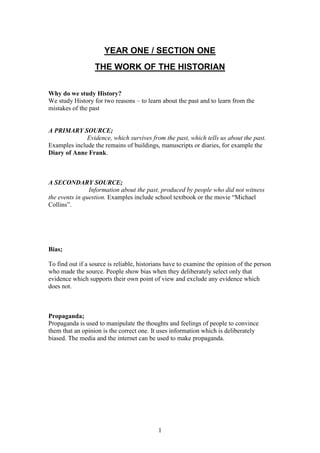The Work of Historians and Archaeologists
•
0 j'aime•425 vues
This document provides an overview of key concepts in historical study and archaeology. It discusses the importance of primary and secondary sources in history and examining sources for bias. It also outlines techniques used in archaeological excavations like surveys, stratigraphy, and carbon dating to determine the age of artifacts. The goal is to learn about the past and from past mistakes.
Signaler
Partager
Signaler
Partager
Télécharger pour lire hors ligne

Recommandé
Recommandé
Contenu connexe
Tendances
Tendances (20)
Mystery of the Revolving Meteorites Resolved By Harry Coumnas

Mystery of the Revolving Meteorites Resolved By Harry Coumnas
Welcome to archaeology camp at the biblical history

Welcome to archaeology camp at the biblical history
Lecture 5 Darwin Vs. God Revised With Margins Final

Lecture 5 Darwin Vs. God Revised With Margins Final
En vedette
En vedette (14)
Notes on International Relations in the 20th Century

Notes on International Relations in the 20th Century
Stone Age, Bronze Age, Iron Age, Celtic and Early Christian Ireland

Stone Age, Bronze Age, Iron Age, Celtic and Early Christian Ireland
History Notes The Reformation and Counter Reformation

History Notes The Reformation and Counter Reformation
History Notes on the Industrial and Agricultural Revolutions

History Notes on the Industrial and Agricultural Revolutions
Similaire à The Work of Historians and Archaeologists
Similaire à The Work of Historians and Archaeologists (20)
Encyclopedia.of.Archaeology.History.and.Discoveries.eBook-EEn.pdf

Encyclopedia.of.Archaeology.History.and.Discoveries.eBook-EEn.pdf
Plus de Noel Hogan
Plus de Noel Hogan (16)
Population and Overpopulation - Leaving Cert Geography

Population and Overpopulation - Leaving Cert Geography
Dernier
https://app.box.com/s/7hlvjxjalkrik7fb082xx3jk7xd7liz3TỔNG ÔN TẬP THI VÀO LỚP 10 MÔN TIẾNG ANH NĂM HỌC 2023 - 2024 CÓ ĐÁP ÁN (NGỮ Â...

TỔNG ÔN TẬP THI VÀO LỚP 10 MÔN TIẾNG ANH NĂM HỌC 2023 - 2024 CÓ ĐÁP ÁN (NGỮ Â...Nguyen Thanh Tu Collection
https://app.box.com/s/x7vf0j7xaxl2hlczxm3ny497y4yto33i80 ĐỀ THI THỬ TUYỂN SINH TIẾNG ANH VÀO 10 SỞ GD – ĐT THÀNH PHỐ HỒ CHÍ MINH NĂ...

80 ĐỀ THI THỬ TUYỂN SINH TIẾNG ANH VÀO 10 SỞ GD – ĐT THÀNH PHỐ HỒ CHÍ MINH NĂ...Nguyen Thanh Tu Collection
Mehran University Newsletter is a Quarterly Publication from Public Relations OfficeMehran University Newsletter Vol-X, Issue-I, 2024

Mehran University Newsletter Vol-X, Issue-I, 2024Mehran University of Engineering & Technology, Jamshoro
Dernier (20)
ICT role in 21st century education and it's challenges.

ICT role in 21st century education and it's challenges.
Sensory_Experience_and_Emotional_Resonance_in_Gabriel_Okaras_The_Piano_and_Th...

Sensory_Experience_and_Emotional_Resonance_in_Gabriel_Okaras_The_Piano_and_Th...
General Principles of Intellectual Property: Concepts of Intellectual Proper...

General Principles of Intellectual Property: Concepts of Intellectual Proper...
Basic Civil Engineering first year Notes- Chapter 4 Building.pptx

Basic Civil Engineering first year Notes- Chapter 4 Building.pptx
TỔNG ÔN TẬP THI VÀO LỚP 10 MÔN TIẾNG ANH NĂM HỌC 2023 - 2024 CÓ ĐÁP ÁN (NGỮ Â...

TỔNG ÔN TẬP THI VÀO LỚP 10 MÔN TIẾNG ANH NĂM HỌC 2023 - 2024 CÓ ĐÁP ÁN (NGỮ Â...
80 ĐỀ THI THỬ TUYỂN SINH TIẾNG ANH VÀO 10 SỞ GD – ĐT THÀNH PHỐ HỒ CHÍ MINH NĂ...

80 ĐỀ THI THỬ TUYỂN SINH TIẾNG ANH VÀO 10 SỞ GD – ĐT THÀNH PHỐ HỒ CHÍ MINH NĂ...
Fostering Friendships - Enhancing Social Bonds in the Classroom

Fostering Friendships - Enhancing Social Bonds in the Classroom
The Work of Historians and Archaeologists
- 1. 1 YEAR ONE / SECTION ONE THE WORK OF THE HISTORIAN Why do we study History? We study History for two reasons – to learn about the past and to learn from the mistakes of the past A PRIMARY SOURCE; Evidence, which survives from the past, which tells us about the past. Examples include the remains of buildings, manuscripts or diaries, for example the Diary of Anne Frank. A SECONDARY SOURCE; Information about the past, produced by people who did not witness the events in question. Examples include school textbook or the movie “Michael Collins”. Bias; To find out if a source is reliable, historians have to examine the opinion of the person who made the source. People show bias when they deliberately select only that evidence which supports their own point of view and exclude any evidence which does not. Propaganda; Propaganda is used to manipulate the thoughts and feelings of people to convince them that an opinion is the correct one. It uses information which is deliberately biased. The media and the internet can be used to make propaganda.
- 2. 2 A Dig; A carefully organised and planned excavation of an archaeological site. (a) Survey the site to find out the size, the shape of the site and the type of soil it contains. (b) Divide the site in a grid and number each section of the grid. (c) The tools that would be used include shovels, axes, brushes and cameras. ARTEFACT; The name given to objects from the past, found on an archaeological site. STRATIGRAPHY; Layers of remains are found one on top of another. The oldest remains are found at the bottom and the newest are found at the top. By measuring the depth at which an artefact is found we can work out roughly how old it is. DENDROCHRONOLOGY; For measuring the age of artefacts made of wood. By examining the annual growth rings on a tree we can work out how old the tree was when it died and what the climate was like when the tree lived. This can lead us to the age of any artefact made using the wood of the tree. CARBON 14 DATING; All living things contain Carbon 14 and when they die the Carbon 14 in them decays at a known rate. By measuring the amount of Carbon14 left in the remains we can work out how old the remains are. Sources’ used include; “Door to the Past” R. Quinn & D O Leary, Folens 2002 and “Focus on the Past”, G. Brockie & R Walsh Gill & McMillan 1997.
